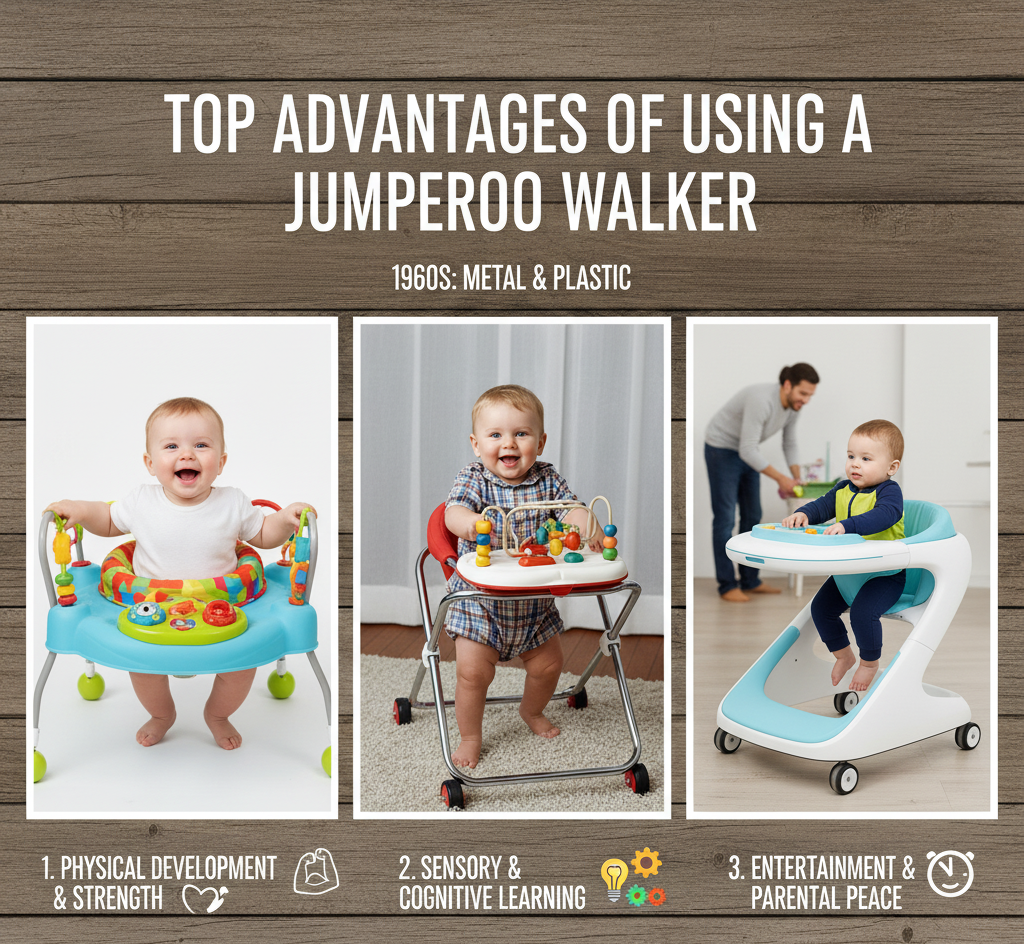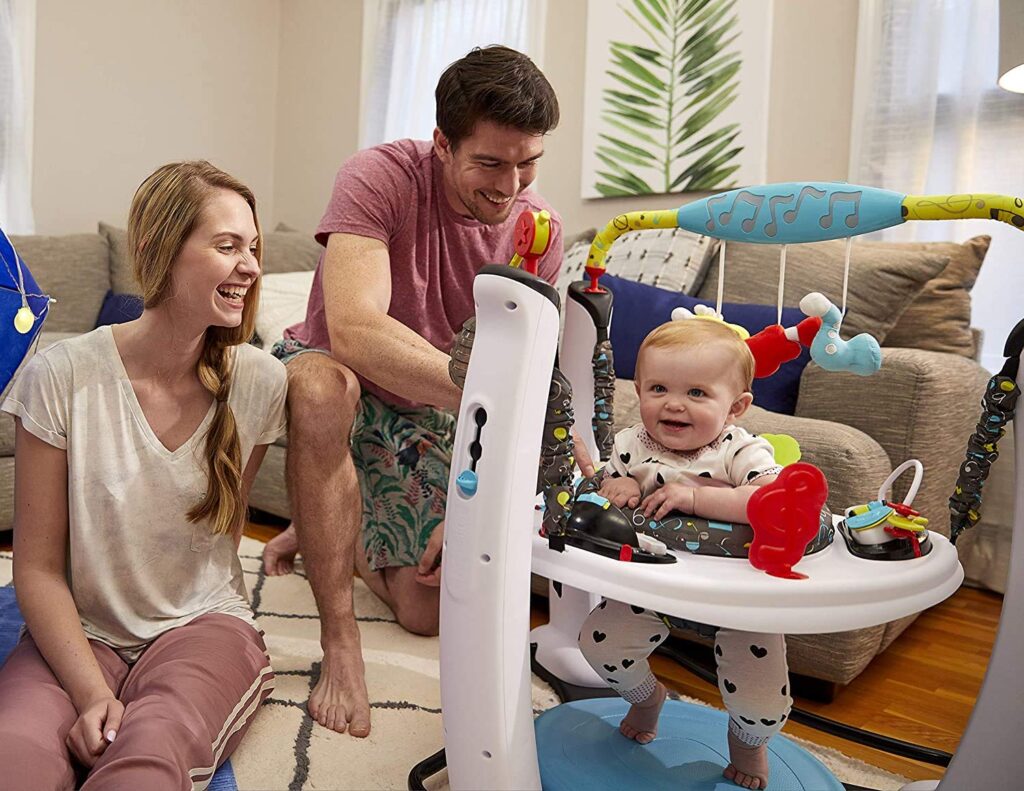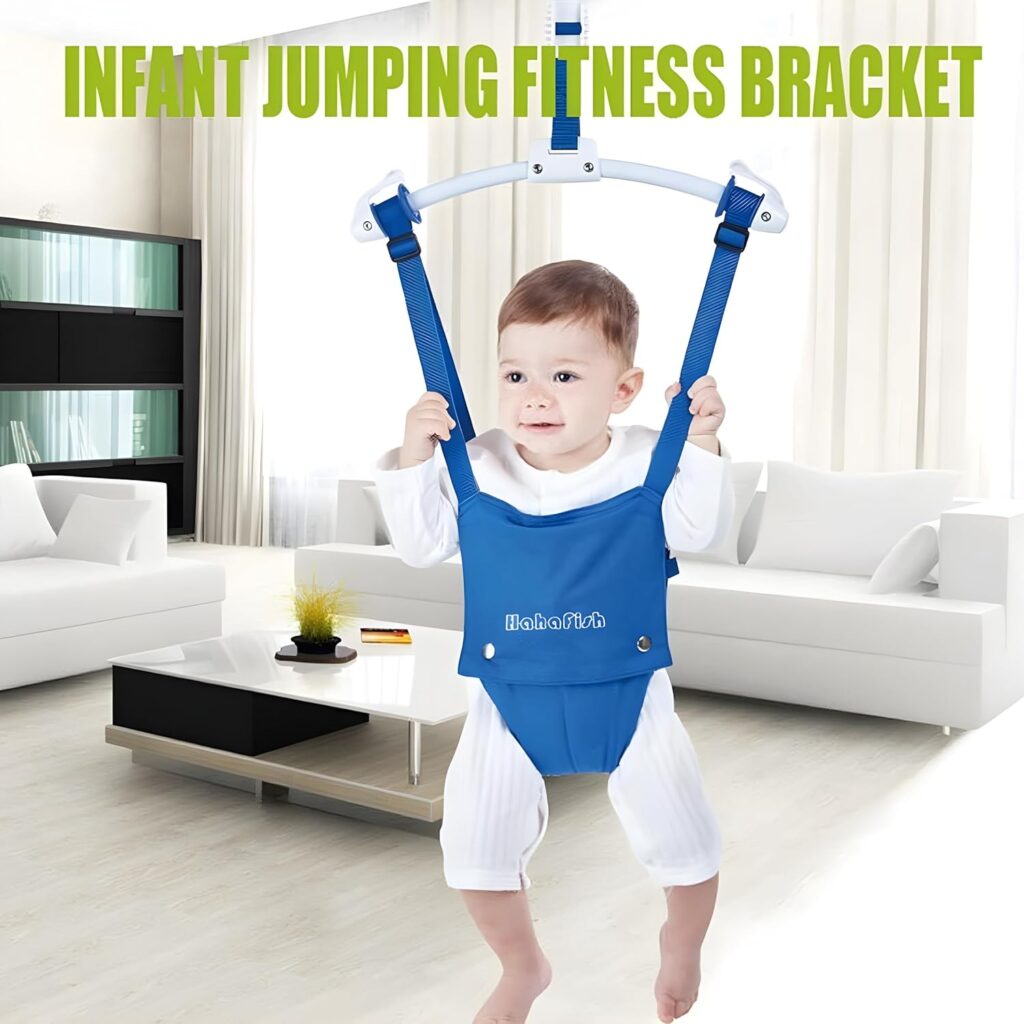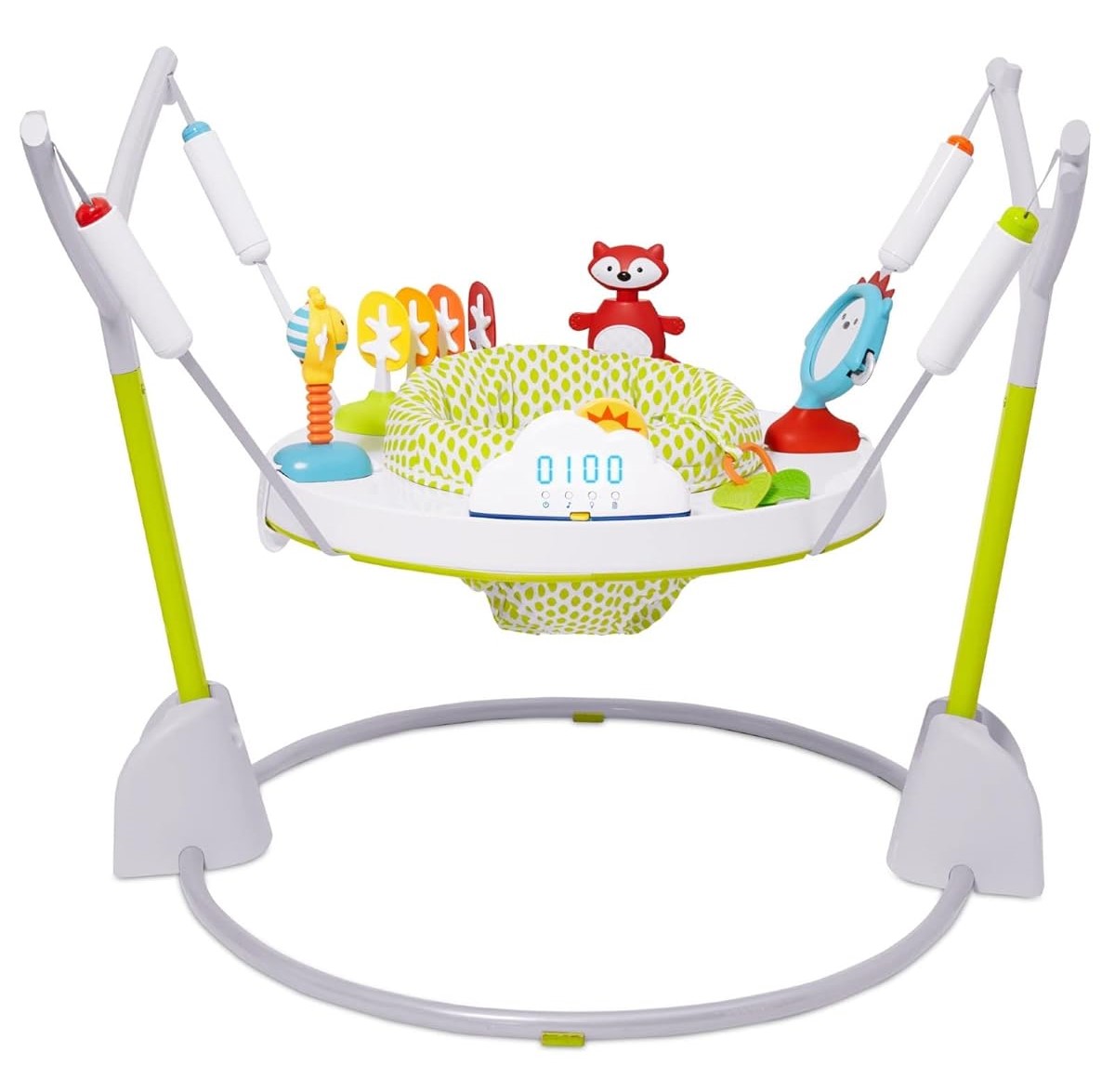Welcome to the color-filled world of jumperoo walker-where fun, exercise, and developmental goodness come for your little one. As a parent who wants to add colors to his/her baby’s routine by making them stronger and more intelligent, keep reading. This guide goes deep into what jumperoo walkers are, why they are amazing, and how you can pick the best one in 2025.
What is a Jumperoo Walker?

A jumperoo walker is essentially a playground and gym packaged into one. It’s a baby activity center where your baby can sit, bounce, and twirl around and be surrounded by musical and interactive toys. Unlike ordinary walkers, jumperoos do not have wheels. They instead bounce around a stationary platform, keeping your infant safe and engage.
Confused Between Jumperoo, Walker, or Activity Center? Let’s Clear It Up!
It is but natural that parents are perplexed as to which one to pick — all three were designed with the purpose of keeping your baby occupied and amused. But they were designed with a bit of a different objective. Let’s set things straight so that you can make the most appropriate decision for your baby’s age, safety, and development.
1.Jumperoo
A Jumperoo is home play centre where your baby can bounce safely on his own leg strength. It typically has:
- Elastic or spring-loaded supports for the bouncing action.
- Interactive toys, lights, and music to engage your baby.
- A 360° rotatable seat, where your baby has all-round view.
Appropriate for: Good head-controlled babies (about 4–6 months and above).
Developmental advantages: Enriches sensory exploration, improves coordination, and strengthens legs’ muscles — without relocation.
2.Conventional Baby Walker
A walker is a wheeled chair that babies walk on using their legs to propel. In spite of the fact that they look like chaos, they do represent a safety risk:
- Mobility risk: Babies can roll into hazard areas such as furniture or stairs.
- Posture problems: Walkers cause babies to tiptoe, not a very good healthy walking position.
- Restricted sensory play: Bare trays or minimal toys in most activity centers.
Appropriate for: Parents who can monitor constantly and use them on level surfaces for short periods.
Developmental advantages: Some mobility but not best for balance or muscle growth.
3.Stationary Activity Center
An activity center is a combination of the two worlds — it’s not springy like a jumperoo but stationary. It invites reaching, twirling, and playing with various toys and textures instead.
Most contemporary activity centers transition to tables with age, providing long-term use.
Appropriate for: Babies learning to sit or stand, typically 4–12 months.
Developmental advantages: Works fine motor, helps develop leg and core muscles, and achieves sensory training without mobility compromise.
Last Tip
You want safety + fun + muscle conditioning? A Jumperoo typically is the compromise. It does get your baby active, engaged, and safe — and, for you, gives you that precious few minutes of respite or gets whatever it is you have to do done.
Support for Development
Jumperoos aid in developing leg muscles, hand-eye coordination, and sensory abilities in babies. Walkers, however, do not contribute much to sensory input or muscle building.Feel still confused between jumperoo, walker, or activity center? Check out our comprehensive guide Baby Walker vs Activity Center 2025 to understand the pros and cons of each.
Top Advantages of Using a Jumperoo Walker

Enhances Motor Skills
Another of the greatest benefits of a Jumperoo walker is how it enhances your baby’s motor skills. The bouncing action tempts your baby to push with his legs, strengthening the muscles he will utilize when he crawls and walks. And the manner in which your baby holds onto the toys attached to the jumper enhances hand-eye coordination and fine motor skills. These unbridled movements enable your infant to comprehend control and balance — vital developmental milestones at an early age.
Encourages Independent Play
A Jumperoo gives babies a safe and stimulating place to play independently. Near yet far away, your infant is able to hear music, be blinded by light, and engage with activity toys — learning to be self-sufficient. Independent play of this sort is worth its weight in gold in building confidence and curiosity. Your baby figures out that they can entertain themselves inside the safety of being enclosed, and parents are treated to a few minutes’ hands-free time uninterrupted.
More Muscles in the Core and Legs
Think of the Jumperoo as your baby’s gym! Every bounce strengthens your baby’s leg muscles and core muscles, building stability and posture. Unlike those bulky, floor-covering old walkers, Jumperoos don’t roll away — safer for your child without sacrificing exercise. Balance and coordination are also improved by the motion, preparing your child for their next developmental milestones such as standing and walking.
Age Guidelines to Use a Jumperoo Safely
It is crucial to implement a Jumperoo at the right time in your baby’s development. Most babies are ready to use it when they reach 4 to 6 months of age, but not ready is muscle control and not age. Make sure that your baby can keep their head up strongly without help and has sufficient strength in the upper part of the body to stay upright. Don’t put very young babies in a Jumperoo too soon because their spine and neck are developing. Never leave the baby unattended during playing, and restrict Jumperoo play for one session to 15–20 minutes to avoid overexertion.
Signs Your Baby is Ready
- Keeps their head up confidently
- Is interested in standing
- Loves bouncing on your lap
- Has good upper body contro
If you’ve ticked most of these, your baby’s probably ready to jump in!
How to Choose the Right Jumperoo Walker
Choosing the perfect Jumperoo is a sort of daunting task — there are simply too many models floating around in the market, each promising fun and safety. The trick is to find one that can accommodate your baby’s age, comfort, and home space. Here’s the whole shebang to help you choose the best.
1.Safety Features to Watch Out For
Safety is always paramount when choosing any baby equipment. Make sure the Jumperoo has a solid base not to tip when jumping strenuously. Ensure there are non-slip feet or rubber stoppers that hold it firmly on smooth floors. It’s also a good idea to choose models that are safety-tested by trials such as ASTM (American Society for Testing and Materials) or EN (European Norm) approval — these ensure the product has undergone trials of quality and safety. Always check that the seat and suspension are properly anchored and there are no pinch points or sharp points.
2.Adjustability and Comfort
A quality Jumperoo also needs to grow with your baby. Opt for models with several height adjustments so that you can simply raise the seat higher as your child gets taller. The seat should be well-padded, but firm, and quick and easy to remove for cleaning purposes — babies get messy when they play! Comfort is crucial as your baby will enjoy more when they are able to bounce around freely and still be comfortable.
3.Interactive Features, Toys, & Music
Jumperoos are not just for jumping — they’re also mini activity stations. Choose one that includes interactive toys, lights, music, and textures to stimulate your baby’s senses. Babies love shiny colors, stimulating noises, and touch-sensitive surfaces. These elements stimulate sensory development and occupy your little baby for longer durations. Some pricier Jumperoos even come with 360° rotating seats, so it can reach all the toys easily.
4.Storage and Portability
If you have an apartment or are short on space, consider a collapsible or foldable Jumperoo. These enable you to fold the unit up and put it away when not using it or take it traveling with you. Some are light enough that you will be able to shuffle them from place to place from room to room so your baby can play where you are. To find out more about how best-selling baby mobility product can be so successful, be sure to catch our detailed guide. Top 5 essential features in baby walker.
Top Jumperoo Walker Picks in 2025
Following are three crowd favorites that have captured parents’ hearts this year:
1.Skip Hop E&M Jumpscape Fold-Away Activity Jumper

Key Features
- 20+ developmental activities with engaging toys to promote motor skills and sensory development.
- A light-up counter keeps track of your baby’s jumps, offering fun sounds, flashing lights, and playful applause as a reward after reaching 100 jumps.
- 360° rotating seat for full access to all toys, encouraging movement and exploration.
- Adjustable to 5 height levels to grow with your baby and ensure long-term use.
- Foldable design for easy storage and portability, ideal for space-saving and travel.
Current Offer : 19,140
MRP : 20,999
2.Evenflo Exersaucer Jump and Learn Activity Centre – Jam Session:

Key Features
- 26+ Interactive Activities – Packed with fun elements to keep your baby engaged while boosting motor skills, hand-eye coordination, and core strength.
- Bouncy Fun with Exer-Bounce – Special enhanced springs offer double the bounce, turning playtime into a joyful, energetic experience.
- 360° Rotating Seat – Lets your baby spin around to explore all the toys and activities, encouraging reaching, stretching, and turning.
- Music, Lights & Learning – Features light-up musical instruments, a baby piano, and multiple music genres to stimulate your baby’s senses and imagination.
- Easy to Clean Design – Comes with a removable, machine-washable seat pad and wipeable toys for stress-free maintenance.
Current Offer : 15,999
MRP : 19,999
3.Baby Door Jumper and Bouncer Swing Exerciser Set

Key Features
- Suitable for babies who can hold their heads up independently, with a maximum weight capacity of 16 kg (35 lbs).
- No assembly required – simply clamp onto a suitable doorway with a secure, sturdy fit.
- Promotes freedom of movement, natural breathing, and physical development through bouncing.
- Adjustable straps grow with your baby, ensuring comfort and long-term use.
- Lightweight and portable, perfect for small spaces and quick setup or transport.
Current Offer : 14,764
MRP : 32,799
Tips for Safe Jumperoo Usage
- Supervise your baby at all times when they are in the jumperoo
- Place it on a flat, firm surface
- Don’t put it near the stairs or sharp-cornered furniture
- Adjust to proper height so that the baby’s feet lightly touch the ground
How Much Time Does a Baby Need on a Jumperoo Daily?
While a Jumperoo is great for your baby to expend energy and build muscles, do make sure not to overdo it. Most experts recommend using a Jumperoo for 15–20 minutes per session at most twice a day. This short time is just the right length of time to give your baby lots of fun having motion and sensory experience without over-exerting their muscles and joints.
Too much Jumperoo use can decelerate normal motor skills at times if it replaces necessary floor play like tummy time, crawling, or independent play. Those floor plays are necessary because they provide your baby with practice in balance, coordination, and body awareness. So the Jumperoo is wonderful for activity time, but it must be part of a total balanced play routine — not the activity for the day.
Common Traps to Avoid
Although Jumperoos are fun and safe, there are a couple of common traps parents must be careful to avoid:
- Early usage: Never place your baby in a Jumperoo until his or her head and neck muscles are strong, usually around 4–6 months old. Putting him in too soon may stress out developing muscles.
- No supervision: Always monitor your baby while he/she jumps. Jumperoos do not travel anywhere, yet still, there are accidents when the baby leans too intensely or tries to stretch outside the jumping perimeter.
- Reliance on it as a babysitter: Jumperoo is for short interactive play and not for sitting the entire day. Babies require social interaction, tummy time, and crawling practice.
Ignoring adjustments in height: With the time your baby begins to grow, make sure that the seat height is adjusted now and then. If too low, your baby’s legs will not bounce properly; if too high, it is overstraining.
All the minute details must be kept in mind so that your baby gets the best from the Jumperoo experience — safely and happily.
Jumperoo Alternatives to Consider
If a Jumperoo is not on your family’s radar, or you simply wish to mix up play time, these developmentally appropriate and safe alternatives are an option:
- Activity Gyms: These are great for sensory play and tummy time. They often have hanging toys, mirrors, and texture that can be reached for, grabbed, and rolled over — all great for early childhood motor skill development.
- Exersaucers: Similar to Jumperoos, but less bouncing. They let your babies play and sit up safely while building up their upper bodies and hand coordination.
- Floor Play with Toys: The most popular and simplest way for babies to master movement skills. Baby-safe toys and soft mats make it easy for your baby to roll, stretch, and crawl on their own — essential for full development and flexibility.
- Sit-Me-Up Seats: Perfect for younger babies who are just learning to hold their heads up. These seats provide gentle support and are great for helping babies practice posture before they transition to more active play equipment.
By offering a mix of activities, you’ll give your baby a well-rounded foundation for motor development — and keep playtime exciting and engaging every day!
FAQs –Jumperoo Walker
1. Does a 3-month-old baby have the ability to use a jumperoo walker?
Nope! Wait until your baby has strong head control—usually around 4 to 6 months.
2. Is jumperoo bad for baby’s legs?
Not if done in moderation. Restrict bouncing sessions and always supervise to avoid overuse.
3. What’s the weight limit for most jumperoo walker?
Typically around 25–30 lbs (11–14 kg). Always check the manufacturer’s guidelines.
4. How do I clean a jumperoo walker?
Most seats are machine washable. Wipe down the frame and toys with a damp cloth and baby-safe cleaner.
5. Can a jumperoo help my baby walk faster?
Not necessarily. It helps with leg strength, but crawling and floor play are more important for walking milestones.

